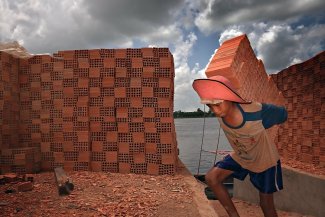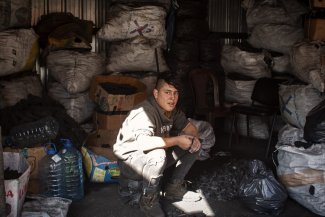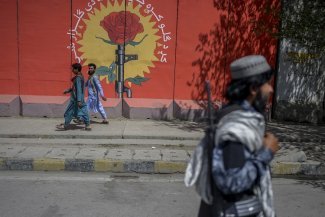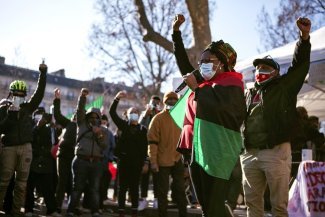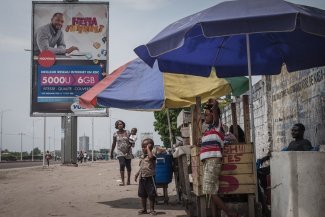A young Afghan boy works as a water carrier at Karte Sakhi cemetery, Kabul, in November 2021. For 10 afghanis (approximately US$0.10), he brings water to families who have come to pay their respects and wish to clean the graves of their loved ones.
[This article is accompanied by a photo report from Kabul, which can be viewed here]
On Barchi Road, one of Kabul’s main thoroughfares, a small figure darts between cars holding up a cardboard box. “10 afghanis [approximately US$0.10] for a coronavirus mask,” says the boy, who is barely seven years old. Further down the street, a little girl knocks on car windows asking for money. In Afghanistan, such scenes are commonplace.
In a 2018 report prepared with the support of the International Labour Organization (ILO), Afghanistan’s labour minister acknowledged that 29 per cent of Afghan children between the ages of five and 17 are engaged in child labour. Human Rights Watch (HRW) had previously reported that a quarter of Afghan children between the ages of five and 14 work for a living, often for long hours, under dangerous conditions and for little pay. These figures are merely estimates: the conditions of war and isolation affecting part of the rural population have made it difficult for government officials and NGOs to obtain an accurate picture. But even these estimates show just how widespread and deeply rooted the phenomenon is in Afghan society, where 45 per cent of the population is under 15 years old.
The practice of child labour is in fact illegal in Afghanistan. In April 2010, the country ratified two key treaties in the fight against child labour: ILO Convention 182 on the worst forms of child labour and Convention 138 on minimum age. Under Afghan law, the minimum age of employment is 18. Minors between the ages of 15 and 17 may work under certain conditions, provided that the work is not arduous, requires less than 35 hours per week and constitutes a form of vocational training. Children aged 14 and under are prohibited from working.
Legislation and action plans aimed at combatting child labour were put into place under the Islamic Republic (2001-2021), mainly supported by the US-backed administration and a section of liberal Afghan civil society. But such efforts have collided with a local reality that continues to fall far short of international standards.
Afghanistan’s high incidence of child labour is mainly due to the extreme poverty of its population. The country remains one of the poorest in the world. As Patricia Grossman, Asia director at HRW, tells Equal Times: “Some families have no other choice. The Afghan economy, damaged by decades of war, needs help. It’s hard to tell poor populations to simply stop these practices.”
In addition to poverty, lack of access to education in remote and conservative regions compounds the problem of child labour. According to the Afghan authorities, 3.5 million children were out of school in 2017, most of them in rural areas. Half of the children who work stop going to school.
“Most Afghan child labourers are employed in the agricultural sector,” says Amanda Bissex, UNICEF regional advisor for child protection in South Asia. “The drought that has been raging for the last three years has led to the impoverishment of rural farmers, which has further intensified the problem.” A significant number of children also work in carpet factories, kilns and mines, not to mention those who engage in unauthorised street trading and begging.
The gap between legislation and reality on the ground is also due to “the lack of resources to engage with communities about these practices and the lack of relevant awareness,” Emma Allen, a research fellow at the Samuel Hall Research Centre, which has an office in Kabul, tells Equal Times.
While the Afghan state, with its very small number of labour inspectors, is limited in its means, this lack of resources is also the result of endemic corruption in the Islamic Republic. Ali [name changed], an official with the NGO War Child Afghanistan, confirms this: “Some children who were forced to work in the drug trade were exploited by networks linked to the corrupt Afghan police. It was impossible to criminalise these groups and thus rescue children from this work.”
Intensified child labour driven by accelerating poverty
Afghanistan’s economy was already in dire straits before the Taliban returned to power in 2021 and the subsequent imposition of international sanctions has plunged the country into an even deeper crisis. After the fall of Kabul on 15 August, Washington froze US$9.5 billion in assets belonging to the Afghan Central Bank to prevent them from falling into the hands of the Taliban. Unpaid salaries of civil servants, a slowdown in the economy, limited access to banks and decreased international aid have accelerated poverty in the country.
In addition, many of the humanitarian organisations that provided some support to poor families have reduced or ceased their activities in recent months. As a result, more than 60 per cent of Afghans are now food insecure according to the World Food Programme. According to the United Nations Development Programme, 97 per cent of the population could fall into poverty by spring 2022 if no action is taken. This situation has only served to intensify the practice of child labour.
Based in Herat, the third largest city in the country, the NGO War Children helps children who have migrated to neighbouring Iran to find work and have been arrested and repatriated to Afghanistan. According to Ali, the number of children seeking work in Iran has increased: “Twice as many are being repatriated to Afghanistan compared to the same period last year.” The same phenomenon exists on the border with Pakistan. In recent months, local media have reported that Afghan children regularly cross the Pakistan-Afghanistan border illegally with smugglers, often hiding under trucks in extremely dangerous conditions.
In addition to the severe economic crisis, the fundamentalist Taliban’s return to power raises its own questions about the intentions of the new Islamic Emirate when it comes to child protection.
Afghan girls are no longer allowed to study at secondary school in most of the country’s provinces and must remain at home from the age of 12. According to Allen of the Samuel Hall Centre, these new measures “could increase girls’ work at home, heavy labour in particular. It could also increase early marriage and begging.”
Child labour affects boys and girls in different ways. According to an April 2021 report by the National Statistics and Information Authority (NSIA), twice as many boys as girls are engaged in work outside the home, while girls are mostly confined to work in their homes, rendering them invisible and thus more difficult to assess.
“They usually work in carpet weaving,” says Ali of War Child. International organisations like Unicef have set up “safe spaces” for dialogue where girls who work at home can speak openly about their lives. Unfortunately, the impact of such programmes remains limited in Afghanistan, where families rarely allow public authorities or international organisations into the private sphere.
An uncertain future
Since assuming power on 15 August, the Taliban have yet to publicly present a child labour policy. According to Allen, “there have been no clear messages on the subject”. The Taliban’s practices when it comes to child protection are cause for concern: “They have used child soldiers in the past,” says Allen. “Their messages and actions on issues of children’s rights, such as education and marriage, have neither recently nor historically been strongly aligned with the international standards set out in the Convention on the Rights of the Child.”
According to Ali of War Child, the Taliban’s priorities since returning to power remain unclear: “Are they really going to support the fight against child labour? Are they going to change the law? We currently have no indications of any kind, we’re completely in the dark.”
The regime change and the establishment of the Islamic Emirate raise many questions about the application of laws previously ratified by the Republic. Back in power after 20 years of insurgency, the Taliban must prove their ability to administer a state. Their policies are currently based on two pillars: security and the establishment of a ‘truly’ Islamist power based on Sharia law (which, significantly, forbids the exploitation of children).
Amanda Bissex of Unicef, one of the few organisations which still remain in the country, is somewhat optimistic: “We have raised the issue of child labour with the Taliban and they shared their concerns with us. They have asked for Unicef’s help in this area.” However, the UN agency’s resources remain limited and international assistance to the population currently takes the form of food and health support to help meet basic needs. Long-term human rights programmes, including those related to education and child protection, remain at the mercy of diplomatic and geopolitical forces.




